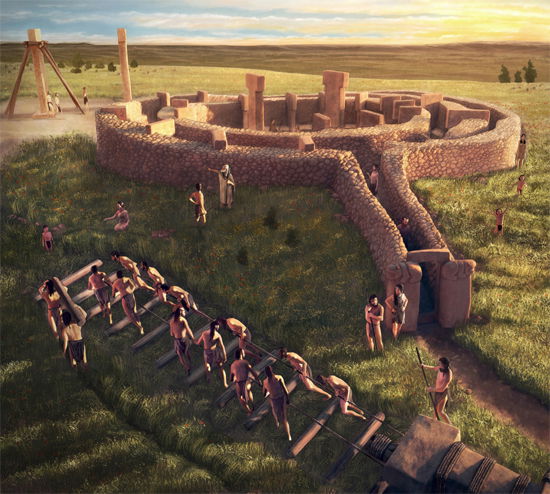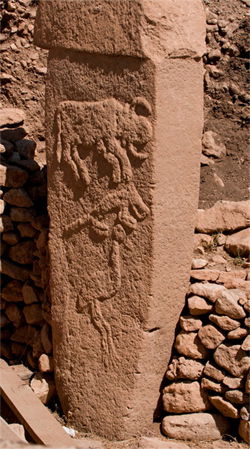
Overturning Expectations About Ancient Man
Monuments at Göbekli Tepe
Most people have heard of Stonehenge and Cheops, but archaeologists have discovered monuments built many years earlier . . . when humans were supposedly hunter-gatherers. How is this possible?
Have you ever watched a construction crew busily raising a large steel building? The massive cranes, earthmovers, and power drills are a tribute to modern ingenuity. Yet we shouldn’t thump our chest. The people who scattered from the Tower of Babel could construct impressive structures, too—and without the benefit of modern tools.

Illustration by Travis Wilson
Everyone is familiar with Stonehenge, but that does not impress archaeologists. Several walled cities had sprung up in other places, and the human race’s engineering abilities were already advanced by this time. According to secular assumptions, hunter-gatherers had already spent thousands of years acquiring the skills and resources necessary to build monuments. At least, that was the assumption . . . until the discoveries at Göbekli Tepe.
In southeastern Turkey overlooking the Harran plain is a site known as Potbelly Hill (Göbekli Tepe in Turkish). You can’t miss it. The 22-acre plateau, located in the Germus range high above the valley, lies just 30 miles (50 km) east of the Euphrates River. Archaeologists began studying the area in 1963, but at first they ignored this mound because it appeared to be just a medieval outpost.
Then in 1994, Klaus Schmidt of the German Archaeological Institute noticed some flint chips and decided to take a closer look. What he discovered overturned secular assumptions about the rise of human culture.
Not Your Typical Neolithic Site

© Vincent J. Musi | National Geographic Creative
A quick glance at the pillars and artwork of Göbekli Tepe shows that these builders were skilled artists and masons. This high relief sculpture of a four-legged reptile with impressive teeth may depict an animal that lived on the nearby plain.
It’s easy to excuse the original lack of interest. Ancient stone toolmakers usually lived and worked near water and game, but this mound is located at the highest elevation of the mountain range, approximately 1,000 feet (305 m) above the surrounding plain. The closest water source is 3 miles (5 km) away. No evidence of livestock has been found at the site, so the builders may have had to travel down to hunt or farm.
Based on the abundance of stone tools and bones from wild animals, this site is classified as Aceramic or Pre-Pottery Neolithic. This means there is no evidence of pottery, not even ceramic figurines, as is common among other sites classified as Pottery Neolithic.
Most tools were made of flint, along with a few made out of bones and antlers. Mortars, pestles, and other stone vessels were made of basalt or limestone and used in the absence of pottery.
Other items of daily life hint that Göbekli Tepe’s residents were much like the other stone toolmakers in the region. They wore small drilled beads, a common jewelry for this period, found with decorated stone vessels, and stone cups and bowls with crafted designs.
Except for the inaccessible location, none of these finds really sets Göbekli Tepe apart from other Pre-Pottery Neolithic locations. What makes this site special is the architecture.
Terrazo Floors
As Schmidt’s team began their work, they soon uncovered buildings containing several rectangular rooms and round structures, with terrazzo floors. The round structures were made out of massive stone pillars, arranged into concentric circles. Each circle was 30 to 100 feet (9–30 m) in diameter.
The terrazzo was made of burnt limestone and clay and then polished to give it a spotted appearance. Terrazzo produced in this way creates a flooring surface that is extremely durable and resistant to moisture.
The terrazzo would have consumed a great deal of energy to produce, but that wasn’t the most amazing detail of Schmidt’s discovery.
Massive Stone Pillars
The most outstanding feature is the T-shaped monolithic pillars. Each column is made from a single piece of stone and ranges in height from 5 feet (1.5 m) to 18 feet (5.5 m) and weighs up to 16 tons (15 m. ton). How were they made?
Some archaeologists speculate that the pillars were transported by human muscle.
Researchers have discovered ancient quarries where the pillars were cut, located a quarter mile away in the surrounding limestone outcropping. At least three of the unfinished columns still lie there, and they appear to have been made with simple flint tools. Some archaeologists speculate that the pillars were transported by human muscle because they have not found any evidence of domesticated beasts of burden.
Schmidt estimates the manpower necessary to move megalithic columns of this size to be at least 500 men.
The number of pillars—and the number of rings into which they were set—is impressive. So far only four circles have been uncovered, containing 47 T-shaped pillars. According to a geomagnetic survey of the mound, which included ground-penetrating radar, there are possibly up to twenty such circular areas.
The sheer size of the pillars and the effort required to create these monumental spaces suggest that they were not homesteads but something much more significant. Most archeologists now believe that Göbekli Tepe was a sanctuary or retreat used for spiritual or communal purposes rather than a city with homes and children.
If so, this does not fit the secular view of human culture, which assumed hunter-gatherers eventually learned to farm, settled down, and only then made monuments. This site has forced archaeologists to consider the possibility that the human drive to build and worship came first.

Illustration by Travis Wilson
Massive Stone Pillars: T-shaped pillars were as large as 18 feet (5.5 m) high and weighed up to 16 tons (15 m. tons).
Transporting Pillars: Pillars were cut from a rock quarry nearly a quarter mile away using simple flint tools. These massive pillars appear to have been moved using human muscle. Archaeologists estimate larger stones could have taken up to 500 men to move.
Abstract Artistry
If we stopped there, the story of Göbekli Tepe would be fascinating enough. But there is more. Not only did the builders create beautiful terrazzo floors and transport 16-ton pillars, but they also fashioned their pillars and stoneware with decorative human and animal motifs.
All the pillars were built with the same abstract design. The rectangular top looks like a head, and then human arms and hands were sometimes carved into the body. These human forms were often clothed with loincloths, jewelry, and belts, complete with buckles.

© Vincent J. Musi | National Geographic Creative
The majority of the artwork at Göbekli Tepe depicts animals. Snakes are most common, but you can also find foxes, boars, asses, cranes, ducks, vultures, scorpions, spiders, bulls, and rams.
The majority of the artwork depicts animals. Snakes are most common, but you can also find foxes, boars, asses, cranes, ducks, vultures, scorpions, spiders, bulls, and rams. A quick glance at the designs shows that these builders were skilled artists and masons.
The fox seems to have played a significant role in the lives of these people. At the center of two circular structures are twin pillars with foxes on them. In one impressive pillar, the fox is held under the right elbow of the human figure, who also appears to be wearing a fox skin. Nowhere else among Pre-Pottery Neolithic sites is the fox image given this much importance. No known ancient religion gives the fox such a significant role, and its role at Göbekli Tepe is still a matter of debate.
Few of the creatures depicted in the stone carvings are among the piles of bones found at the site. Instead, over 90% of the bones are of hoofed animals such as the wild ass. So it appears that the carved animals were not decorations about daily life but had symbolic significance.
Bible-believing Christians find one creature of particular interest. In Enclosure C’s “pillar 27” is a four-legged reptile with impressive teeth. Schmidt calls it a predator and interprets it as a mythological creature that guarded the sanctuary or the people of Göbekli Tepe. But since all the other animals are real and lived on the Harran plain, perhaps this was a living creature as well. The fossil record includes many four-footed reptiles that had erect stances, broad heads, and predatory teeth, such as the Proterosuchia. These reptiles, which could grow up to 10 feet (3.5 m) in length, would have been among the animals saved on Noah’s Ark.
Perhaps the builders of Göbekli Tepe were familiar with these predators because they still lived in the area. If so, they would have been the chief predator of the Harran plain.

© Vincent J. Musi | National Geographic Creative
The fox seems to be given a significant role at Göbekli Tepe, but its role is still a matter of debate.
A Religious Center?
So how do we classify a place such as Göbekli Tepe? Was it a religious sanctuary? Could the enclosures have been hunting lodges with symbols telling the stories of hunts past? As more research and excavation is done the site will no doubt answer some of these questions.
What is apparent is that the people of Göbekli Tepe devoted enormous energy, time, and craft to construct and maintain these buildings. Schmidt estimates that hundreds of people would need many years to complete just one structure. So this must have been a very important place to the Neolithic people, who lived in the centuries just after the dispersion from Babel. So the next time you are tempted to boast about the wonders of a modern building, think of Göbekli Tepe.
Answers Magazine
April – June 2014
A closer look at the Genesis Flood account reveals a beautifully written, unified narrative that points to one inspired author. The passage masterfully highlights one central message: “God remembered Noah.” Along with in-depth articles on the Flood, this issue shows biblical and historical evidences of Christ’s Resurrection, new discoveries about the miracle of a butterfly’s metamorphosis and much more!
Browse Issue SubscribeRecommended Resources

Answers in Genesis is an apologetics ministry, dedicated to helping Christians defend their faith and proclaim the good news of Jesus Christ.
- Customer Service 800.778.3390
- © 2024 Answers in Genesis






